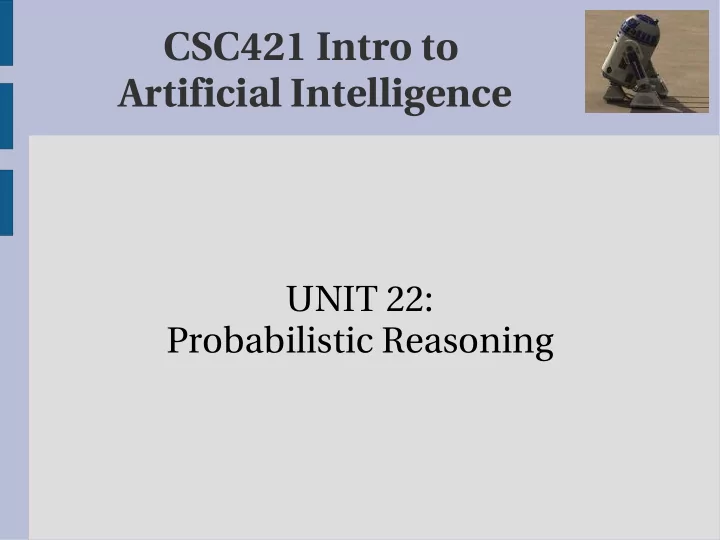

CSC421 Intro to Artificial Intelligence UNIT 22: Probabilistic Reasoning
Midterm Review ● Rooks, bishop, pawns ● Edit distance
Baysian Networks ● A simple, graphical notation for conditional independence assertions and for compact specification of full joint distributions ● Syntax: – Each node is a RV (continuous or discrete) – A directed acyclic graph (link “directly influences”) – A conditional distribution for each node given it's parents ● P(X i | Parents(X i ) ● Simplest case (CPT) – distribution over X i for every combination of parent values
Topology Topology of network encodes conditional independence assertions Weather Cavity Catch Toothache Weather is independent of the other variables Toothache and Catch are conditionally independent given cavity
Example
Compactness ● A CPT for boolean X i with k boolean parents has 2 k rows for the combinations of parent values ● Each row requires one number p for X i = true (1-p for false) ● If each variables has no more than k parents then complete network O(n * 2 k ) numbers ● Full joint O(2 n )
Global Semantics ● Global semantics defines the joint distribution as the product of the local continuous distributions ● P(x 1 , ... x N ) = Π N P(x i | Parent(X i )) i=1 ● e.g P(j, m, a, ¬ b, ¬ a) = ?
Constructing BNs ● Need a method such that a series of locally testable assertions conditional independence guarantee global semantics ● Intuitively: – Start from root causes and expand effects – (follow causality) ● Details: – Read textbook
Some BNs are better than others ● Deciding conditional independence in non- causal directions is hard ● Assessing conditional probabilities in non- causal directions is hard ● Network is less compact
Example: Car Diagnosis
Hybrid (discrete + continuous) networks Discrete (Subsidy?, Buys?) Continuous (Harvest, Cost) Option 1: Discretization - possibly large erros, large CPTs Option 2: Finitely parametrized canonical families 1) Continuous variable (discrete & continuous parents) (e.g. Cost) 2) Discrete variable (continuous parents) (e.g Buys? )
Continuous Child Variables ● Need one conditional density function for child variable given continuous parents for each possible assignment to discrete parents ● Most common linear Gaussian model: – P(Cost = c | Harvest =h, Subsidy = true) = N(a t h + b t, , σ t )(c) ● All continuous network with LGs then joint distribution is multivariate Gaussian ● Discrete + continuous = conditional Gaussian (multivariate Gaussian for every setting of all discrete variables)
Discrete Variable with continuous parents ● Probability of Buys ? given Cost should be a soft threshold Probit distribution = integral of Gaussian Sigmoid (or Logit) distribution = also used in Neural Networks
Why probit ? ● It's sort of the right shape ● Can be viewed as a hard threshold whose location is subject to noise
Summary ● Bayesian networks provide a natural representation for (causally induced) conditional independence ● Topology + CPT = compact reprsentation of joint distribution ● Generally easy for (non) experts to construct ● Continuous variables => parametrized distributions (e.g linear Gaussian) ● Extra: – Canonical distributions (noisy-OR)
Recommend
More recommend